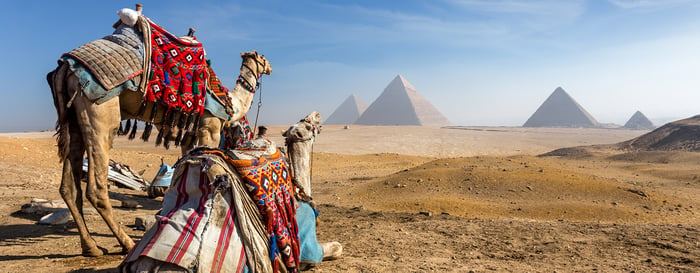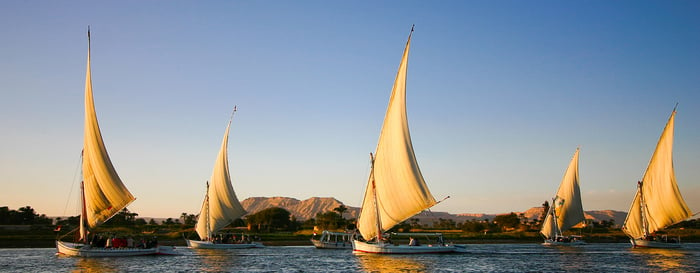Sarah Davis spent six months paddling and rafting 4,100km from Rwanda to Egypt
This as-told-to essay is based on a conversation with Sarah Davis. It has been edited for length and clarity.
When the paddles hit the water of the Nile on 27 October 2018 in Rwanda, it was just this incredible moment. All the worries and stress melted away as we start to paddle along the muddy-coloured waterway. This was it – the beginning of my six-month long adventure. After two years of planning, I was already on a high to get to this point. Villagers gathered by the river to give us an impromptu send-off. For the next five kilometres, the children whooped and cheered as they ran alongside us on the riverbank, while we began to paddle along the longest river in the world. It was amazing. I began to feel that if this was the only day we spent on the Nile, it would be enough. Yet, 6,953km later on 21 April 2019 I reached the Mediterranean Sea.
My adventure began on New Year’s Day 2016. I would start each year the same way, by watching the sunrise over Bondi Beach. While I had a rewarding job working as a risk manager for the Macquarie Group, I had a nagging feeling I needed a change. As I started to think about what this challenge could be I read about a couple of expeditions. But what struck me about these adventurers, was that they were just ordinary people striving to do the extraordinary.
When I wasn’t in the office, I would usually take a kayak out onto the ocean. I competed in the 2017 world championships and took part in the Molokai Surfski Race in Hawaii. I knew that I wanted my expedition to be paddling based and eventually I came up with the idea of paddling along the Nile. The plan would be to start in Rwanda, then paddle through Tanzania, Uganda, Sudan, and Egypt. I would paddle in a raft for three months over rapids, and across hippo and crocodile territory, then I would use a kayak for the rest of the way.

While the planning was lengthy, it was worth it. By the time I put my paddle in the water in Rwanda, I had built a network of kayakers in Uganda, Sudan, and Egypt and hired a support team who would track my journey via satellite each day.
On the first day of the expedition, I was joined by three other paddlers from a whitewater rafting company in Uganda, who would support me for the first leg of the journey. We set up the raft, then packed it to the gills with barrels of clothes, food, camping equipment, satnavs, and power banks.
My biggest fears for the trip were the animal risks and I came face-to-face with this fear on day six. Winding our way along a narrow waterway, where our view was blocked by a sandbank, a baby hippo popped up in front of us. Before I could even ask where the mother was, she had sunk our jaws into the back of the raft. We had unwittingly drifted between the mother and baby, the worst possible place to be. The mother came at us, and put her head under the raft, seemingly to try and flip it. As we tried to paddle away from her she came at us again. I felt a sudden tug on the craft and I turned to see the hippo attached to the back of the raft. She had sunk her teeth and left a gaping hole. She let go momentarily, due to the rush of air through the hole she created and this gave us a short window to get to the riverbank. While my teammates patched the raft, I couldn’t help but think this was day one in hippo territory and we still had weeks to go.
While hippos and crocodiles were constantly on my mind, constant headwinds were in my face. The challenges kept coming. When we paddling along the Nile in Sudan, I could see what I thought was a low cloud on the horizon, but my fellow Sudanese paddlers, who had joined me from Khartoum, told me that it was a sandstorm and it was coming our way. The Sudanese paddlers arranged for a hard-hulled support boat for this leg of the journey so jumped out of our kayaks, buried them in the bank, and tried to sleep in the support boat while the wind and sand swirled around us.

I met some incredible people on this journey. From the kayakers who joined me on the river, to the locals who offered a helping hand. One day in Uganda, when the swathes of thick, impenetrable papyrus, stopped us from pitching our tent on the banks of the river, the chairman of a nearby village, welcomed us into his home.
There were also many unexpected moments, such as when I was invited to a wedding in Khartoum. Over 1,000 people celebrated with the bride and groom.
My journey was not only marked by days in the calendar but the ever-changing scenery. We moved from the muddy, nutrient-rich water within the jungles of Rwanda, to the red deserts of Sudan. And once we reached Aswan in Egypt, the Nile was sparkling and clear. When I reached Egypt, I had been paddling for five months. Even though there was 1,200km to go, as this was the last border I would pass through it felt like the home stretch.
Nadim, a paddler from Egypt, joined me for this final leg of the journey. I was fatigued mentally, physically, and emotionally, but Nadim’s fresh enthusiasm helped spur me on. However, reaching the vibrant, noisy town of Aswan, was a shock to the system, after paddling in relative quiet for so long. The river traffic became a little busier as the cruise ships glided between Luxor and Aswan. When we left the cities, the river returned to its quiet way of life.

While the finish line was getting closer, I did take the time to visit the ancient temples in Abydos. Looking up at these huge temples, engraved with meticulous details, it’s not hard to be in awe.
As I got closer to the end of the trip, it was a real mix of emotions. I was really happy to reach the end, but at the same time, I was sad this journey was over.
My support team had been tracking me solidly for six months and I knew that I was ready to cross the finish line.
On the morning of the last day of my journey, I was suffering from dehydration and fatigue, but when I got down to the river and saw the sparkling blue water, I immediately found a burst of energy and said to myself ‘okay it’s time to bring this home’. I had just 12 kilometres left to do and it wasn’t long before I could smell the salt of the sea air. At Rosetta, I had reached the end of the Nile and the Mediterranean was in front of me. My phone started to ring and Dave who led the team tracking my progress on the satnav, was at the end of the line to congratulate me.
This Nile trip made me come alive like nothing else. While I was at the end of this journey, I knew there was going to be more. I now plan to do a source-to-sea descent on each continent.
Davis published a book about her journey in July 2022 called Paddle The Nile: One Women’s Search For A Life Less Ordinary.
Classic Egypt
- Come face to face with the Great Pyramids of Giza
- Witness Luxor from a hot air balloon, one of the biggest open-air museums in the world
- Cruise down the River Nile, visiting ancient sites along the way
- Visit Abu Simbel, a magnificent site dedicated to Ramses II
- Enjoy a guided tour around the temple of Luxor and the Temple of Karnak
Egypt For Families
- See ancient mummies at the famed Egyptian Museum
- Crawl through the tombs in the Great Pyramid of Cheops
- Go camel riding through the desert
- Sail down the Nile aboard your luxury cruise, with activities for the whole family
- Enjoy relaxation by the Red Sea after plenty of learning and exploration








